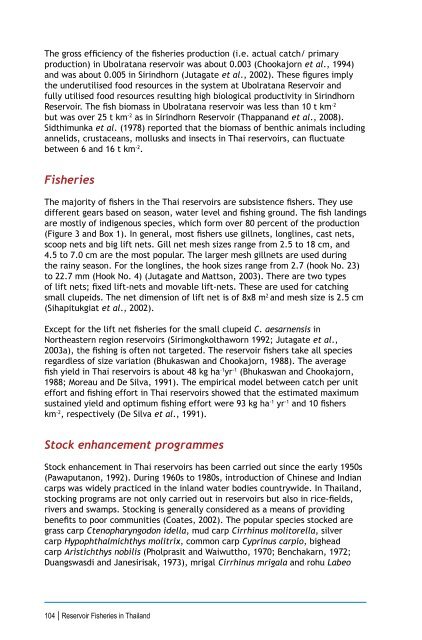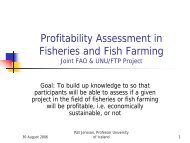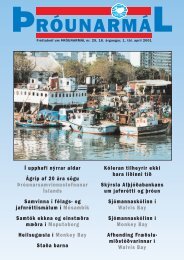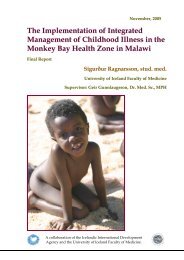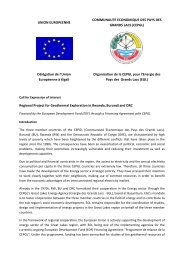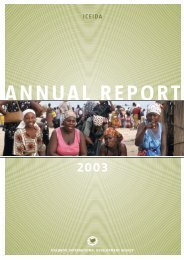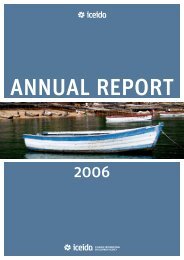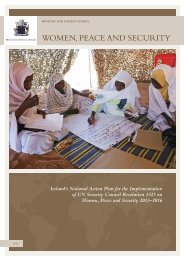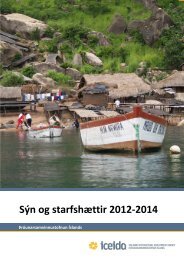Reservoir Fisheries of Asia
Reservoir Fisheries of Asia
Reservoir Fisheries of Asia
You also want an ePaper? Increase the reach of your titles
YUMPU automatically turns print PDFs into web optimized ePapers that Google loves.
The gross efficiency <strong>of</strong> the fisheries production (i.e. actual catch/ primary<br />
production) in Ubolratana reservoir was about 0.003 (Chookajorn et al., 1994)<br />
and was about 0.005 in Sirindhorn (Jutagate et al., 2002). These figures imply<br />
the underutilised food resources in the system at Ubolratana <strong>Reservoir</strong> and<br />
fully utilised food resources resulting high biological productivity in Sirindhorn<br />
<strong>Reservoir</strong>. The fish biomass in Ubolratana reservoir was less than 10 t km -2<br />
but was over 25 t km -2 as in Sirindhorn <strong>Reservoir</strong> (Thappanand et al., 2008).<br />
Sidthimunka et al. (1978) reported that the biomass <strong>of</strong> benthic animals including<br />
annelids, crustaceans, mollusks and insects in Thai reservoirs, can fluctuate<br />
between 6 and 16 t km -2 .<br />
<strong>Fisheries</strong><br />
The majority <strong>of</strong> fishers in the Thai reservoirs are subsistence fishers. They use<br />
different gears based on season, water level and fishing ground. The fish landings<br />
are mostly <strong>of</strong> indigenous species, which form over 80 percent <strong>of</strong> the production<br />
(Figure 3 and Box 1). In general, most fishers use gillnets, longlines, cast nets,<br />
scoop nets and big lift nets. Gill net mesh sizes range from 2.5 to 18 cm, and<br />
4.5 to 7.0 cm are the most popular. The larger mesh gillnets are used during<br />
the rainy season. For the longlines, the hook sizes range from 2.7 (hook No. 23)<br />
to 22.7 mm (Hook No. 4) (Jutagate and Mattson, 2003). There are two types<br />
<strong>of</strong> lift nets; fixed lift-nets and movable lift-nets. These are used for catching<br />
small clupeids. The net dimension <strong>of</strong> lift net is <strong>of</strong> 8x8 m 2 and mesh size is 2.5 cm<br />
(Sihapitukgiat et al., 2002).<br />
Except for the lift net fisheries for the small clupeid C. aesarnensis in<br />
Northeastern region reservoirs (Sirimongkolthaworn 1992; Jutagate et al.,<br />
2003a), the fishing is <strong>of</strong>ten not targeted. The reservoir fishers take all species<br />
regardless <strong>of</strong> size variation (Bhukaswan and Chookajorn, 1988). The average<br />
fish yield in Thai reservoirs is about 48 kg ha -1 yr -1 (Bhukaswan and Chookajorn,<br />
1988; Moreau and De Silva, 1991). The empirical model between catch per unit<br />
effort and fishing effort in Thai reservoirs showed that the estimated maximum<br />
sustained yield and optimum fishing effort were 93 kg ha -1 yr -1 and 10 fishers<br />
km -2 , respectively (De Silva et al., 1991).<br />
Stock enhancement programmes<br />
Stock enhancement in Thai reservoirs has been carried out since the early 1950s<br />
(Pawaputanon, 1992). During 1960s to 1980s, introduction <strong>of</strong> Chinese and Indian<br />
carps was widely practiced in the inland water bodies countrywide. In Thailand,<br />
stocking programs are not only carried out in reservoirs but also in rice-fields,<br />
rivers and swamps. Stocking is generally considered as a means <strong>of</strong> providing<br />
benefits to poor communities (Coates, 2002). The popular species stocked are<br />
grass carp Ctenopharyngodon idella, mud carp Cirrhinus molitorella, silver<br />
carp Hypophthalmichthys molitrix, common carp Cyprinus carpio, bighead<br />
carp Aristichthys nobilis (Pholprasit and Waiwuttho, 1970; Benchakarn, 1972;<br />
Duangswasdi and Janesirisak, 1973), mrigal Cirrhinus mrigala and rohu Labeo<br />
104 | <strong>Reservoir</strong> <strong>Fisheries</strong> in Thailand


